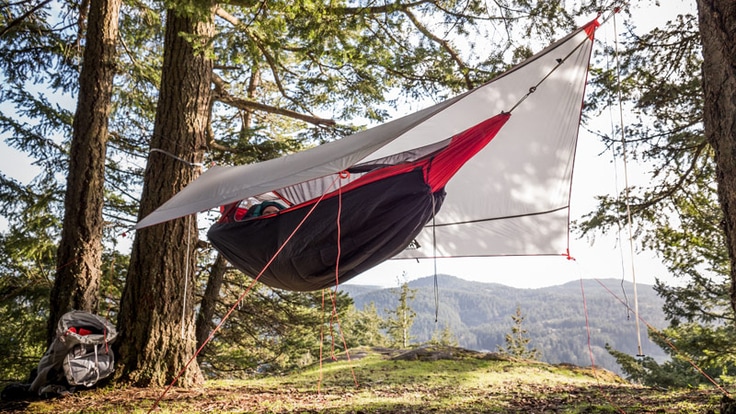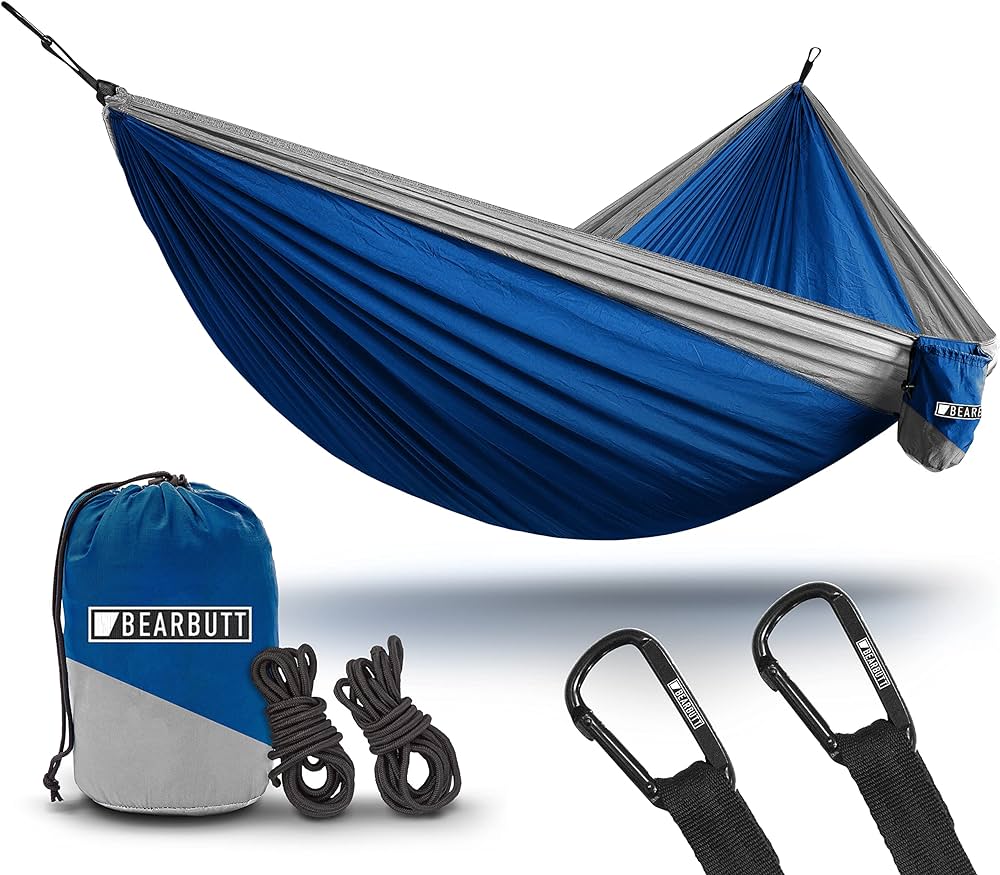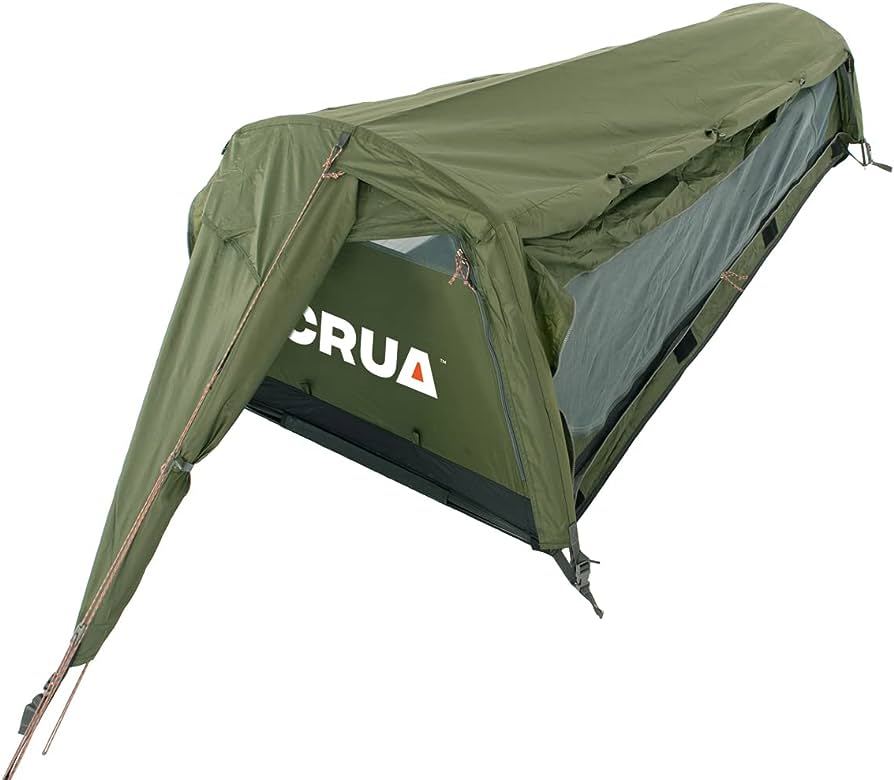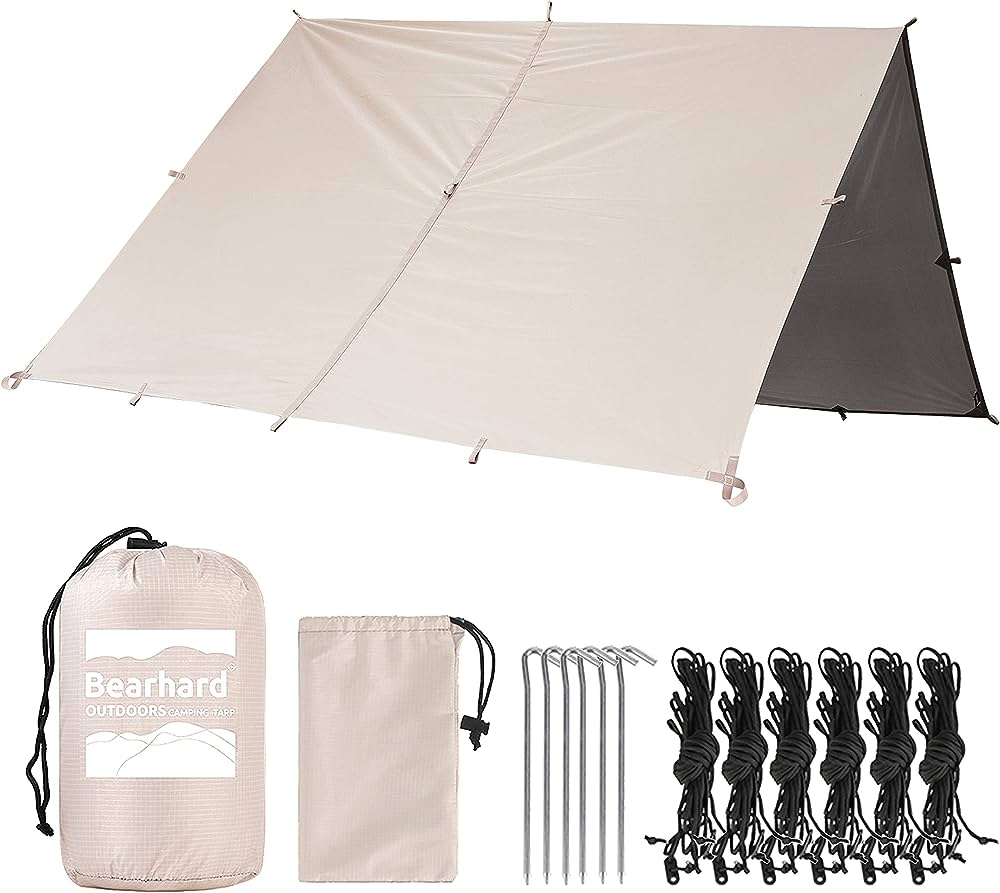- 8 Airplane Footrest Hammock!Travel comfortably - October 9, 2023
- top 7 Pool Float Water Hammock for a Relaxing Summer - October 9, 2023
- top 5 Space SaverSingle Hammock Stand Maximize Comfort and Space - October 9, 2023
To store your backpack when hammock camping, hang it on a nearby tree using a carabiner or strap system. This ensures easy access and keeps it off the ground.
Hammock camping has become an increasingly popular outdoor activity for nature enthusiasts. It allows for a comfortable and relaxing night’s sleep, suspended between two trees. However, when it comes to safely storing your backpack during this type of camping, you need to consider a few important factors.
Keeping your backpack off the ground is crucial to prevent critters from getting into your food or gear. Additionally, having easy access to your backpack is essential for convenience and organization. In this guide, we will explore the best methods to store your backpack when hammock camping, ensuring it is secure, accessible, and protected from any potential hazards.
Essential Gear For Hammock Camping
Essential Gear for Hammock Camping
Hammock camping is a unique and exhilarating experience that allows you to enjoy nature without the constraints of a traditional camping setup. However, to make the most of your hammock camping trip, it’s crucial to have the right gear. In this section, we will discuss the essential gear checklist for a successful hammock camping trip, as well as lightweight and compact gear options for backpack storage. We will also delve into considerations for different weather conditions to ensure you are well-prepared for any situation.
Selecting The Right Backpack For Hammock Camping
When it comes to hammock camping, selecting the right backpack is essential. Backpacks designed specifically for camping provide the necessary features and functionality to ensure a comfortable and convenient camping experience. Consider the following factors when choosing a backpack:
- Capacity: Opt for a backpack with enough capacity to carry your camping essentials, including your hammock, sleeping bag, cooking gear, and extra layers of clothing.
- Weight: Look for a lightweight backpack that keeps your load manageable, especially if you plan on embarking on long hikes to your camping spot.
- Comfort: Prioritize backpacks with adjustable padded straps and back support to evenly distribute the weight and minimize strain on your body.
- Durability: Ensure that the backpack is made from sturdy materials that can withstand rough terrain and potential weather conditions.
Essential Gear Checklist For A Successful Hammock Camping Trip
When packing for a hammock camping trip, it’s crucial to have a comprehensive checklist to ensure you don’t forget any necessary gear. Here is a list of essential items:
| Camping Gear | Essential |
|---|---|
| Hammock | ✓ |
| Sleeping bag | ✓ |
| Tarp or rainfly | ✓ |
| Tree straps or suspension system | ✓ |
| Mosquito net | ✓ |
| Cooking gear (stove, utensils, etc.) | ✓ |
| Light source (headlamp or flashlight) | ✓ |
| First aid kit | ✓ |
Lightweight And Compact Gear Options For Backpack Storage
When it comes to storing your backpack during hammock camping, opting for lightweight and compact gear is crucial to maximize space and ensure easy transportation. Consider the following options:
- Compression sacks: These handy sacks allow you to compress your gear, reducing its overall volume.
- Roll-top dry bags: These waterproof bags keep your gear dry and can be easily attached to your backpack or secured to your hammock straps.
- Organizational cubes: These lightweight cubes help compartmentalize your gear and keep everything organized, making it easier to find what you need.
- Multi-purpose tools: Look for compact tools that serve multiple functions, such as a camping spork that can be used as both a spoon and a fork.
Considerations For Different Weather Conditions
When planning a hammock camping trip, it’s essential to consider the potential weather conditions you may encounter. Here are a few important considerations:
- Rainy weather: Pack a waterproof tarp or rainfly to protect yourself from rain, ensuring you stay dry throughout the night.
- Cold weather: Invest in a high-quality sleeping bag rated for colder temperatures to keep you warm and comfortable during chilly nights.
- Hot weather: Look for hammocks with built-in ventilation or opt for lightweight materials that allow for better airflow, keeping you cool and refreshed.
- Bug-infested areas: Use a mosquito net to protect yourself from pesky insects and ensure a peaceful night’s sleep.
By considering these weather-related factors, you can ensure that you are well-prepared for any conditions you might encounter during your hammock camping adventure.
Organizing Your Backpack For Efficient Storage
When hammock camping, efficiently organizing your backpack is crucial for a hassle-free outdoor experience. With limited space and the need to access your essential items quickly, adopting proper packing techniques and utilizing storage solutions such as compression sacks and packing cubes can make a significant difference. Categorizing your gear and strategically placing heavy items will not only optimize space but also ensure convenient retrieval and organization of your belongings. In this article, we will explore these techniques in further detail to help you store your backpack effectively when hammock camping.
Optimal Packing Techniques For Easy Access To Essential Items
Organizing your backpack starts with packing your essential items in a manner that allows for easy access. Here are some optimal packing techniques to consider:
- Place frequently used items such as your water bottle, snacks, and headlamp in accessible outer pockets or the top compartment of your backpack.
- Store clothing and other non-essential items at the bottom of the main storage compartment.
- Roll or fold your clothes tightly to maximize space and keep them wrinkle-free.
- Use small zipper bags or pouches to group small items together, preventing them from getting lost or tangled.
Utilizing Compression Sacks And Packing Cubes For Space Optimization
Compression sacks and packing cubes are excellent tools for optimizing the available space in your backpack. Consider the following tips for their usage:
- Compression sacks: These sacks allow you to compress bulkier items such as sleeping bags or jackets, freeing up space in your backpack. Place these compressed items at the bottom or sides of the main compartment.
- Packing cubes: Use packing cubes to group similar items together, keeping your gear organized and easily accessible. For example, dedicate one cube to your cooking utensils, another for hygiene essentials, and so on. Place these cubes strategically to maximize space.
Categorizing Gear For Quick Retrieval And Organization
Categorizing your gear ensures quick retrieval and maintains an organized backpack throughout your hammock camping trip. Consider the following categorization approach:
| Category | Suggested Gear |
|---|---|
| Cooking | Cooking utensils, stove, fuel canister, lighters |
| Sleeping | Sleeping bag, sleeping pad, pillow |
| Hygiene | Toiletries, towel, wet wipes, hand sanitizer |
| Emergency | First aid kit, whistle, emergency blanket |
Strategic Placement Of Heavy And Bulky Items In Your Backpack
Placing heavy and bulky items strategically within your backpack helps achieve better weight distribution and enhanced stability during your hammock camping experience. Consider these placement tips:
- Position heavy items closer to your back, preferably in the middle of your backpack, to maintain your center of gravity.
- Place bulky items such as your sleeping bag or tent vertically, along the sides of your backpack, to utilize space effectively.
- Store fragile items, like your cooking gear or electronics, towards the center of your backpack, surrounded by soft, cushioning items, to protect them from potential impact.
Streamlining Backpack Storage With Gear Attachments
When hammock camping, your backpack becomes not only your trusted companion but also your storage unit for all your essential gear. Properly organizing and securing your gear can make a world of difference in your camping experience. One way to achieve this is by utilizing gear attachments on the exterior of your backpack. These attachments offer easy accessibility, streamlined storage, and the ability to carry extra gear without taking up valuable space in your pack. In this article, we will explore the various methods and benefits of using gear loops and carabiners for exterior storage options, as well as provide tips on securing your attached gear to ensure a quiet and hassle-free camping trip.
Utilizing Gear Loops And Carabiners For Exterior Storage Options
Gear loops and carabiners are versatile tools that allow you to attach items to the outside of your backpack, maximizing your storage capacity and providing easy access to frequently used gear. Gear loops are typically built into backpack designs, featuring loops or straps that can be used to secure your gear. Carabiners, on the other hand, are small metal clips that can be easily attached to gear loops or other attachment points on your backpack. Here are some popular ways to make the most of these exterior storage options:
- Attach your water bottle to a gear loop or carabiner for quick hydration on the trail.
- Secure your hiking poles to the side of your backpack using carabiners and gear loops, freeing up your hands when you reach camp.
- Hang your wet clothes or towel on a carabiner to let them air dry while you hike.
- Fasten a small pouch or pocket to a gear loop for easy access to essentials like snacks, a compass, or a multi-tool.
Attaching Gear To The Outside Of Your Backpack For Easy Accessibility
One of the main advantages of using gear attachments is the ease of accessibility they provide. By attaching gear to the exterior of your backpack, you can quickly grab what you need without having to dig through your pack. This is especially beneficial for items you might need during your hike, such as snacks, a map, or a rain jacket. With gear attachments, you won’t have to disrupt your flow or waste time searching for essentials; they will be right at your fingertips whenever you need them.
Pros And Cons Of Different Attachment Methods For Various Gear Items
While gear attachments offer great convenience, it’s important to consider the pros and cons of different attachment methods when securing various gear items. Here is a breakdown of the most commonly used methods:
| Attachment Method | Pros | Cons |
|---|---|---|
| Gear Loops | Secure and built-in attachment points | May have limited space and flexibility |
| Carabiners | Quick and easy attachment | May create noise if not properly secured |
When deciding which attachment method to use for specific gear items, consider their weight, size, and personal preference. It’s essential to ensure that your attachments are secure and won’t come loose during your hike.
Tips For Securing Attached Gear To Avoid Noise And Interference
When attaching gear to the outside of your backpack, it’s crucial to secure it properly to avoid noise and interference. Here are some tips to keep in mind:
- Double-check that each attachment is securely fastened before hitting the trail.
- Use rubber bands or straps to keep items from rattling or moving around.
- Place soft or padded items between hard objects to prevent clanging.
- Avoid overpacking the exterior of your backpack, as this can affect your balance and cause discomfort.
By following these tips, you’ll be able to enjoy a quiet and peaceful hike without the distraction of noisy gear.
Streamlining your backpack storage with gear attachments is a game-changer for hammock camping. It allows for easy accessibility of frequently used gear and maximizes your storage capacity. Whether you opt for gear loops or carabiners, knowing the pros and cons of different attachment methods is essential. Just remember to secure your gear properly to avoid any unwanted noise or interference during your adventure. Now, you’re all set to embark on your hammock camping trip with a well-organized and efficiently packed backpack.

Credit: www.rei.com
Properly Securing And Protecting Your Gear While Hammock Camping
When hammock camping, it is crucial to properly secure and protect your gear to ensure a comfortable and stress-free outdoor experience. The last thing you want is gear shifting, potentially causing items to fall out of your backpack. Additionally, sensitive gear items like electronics or clothing require proper waterproofing and protection from the elements. It is also important to protect fragile items from damage by utilizing appropriate padding and storage methods. In this blog post, we will discuss various strategies and techniques for properly securing and protecting your gear while hammock camping.
Preventing Gear From Shifting And Potentially Falling Out Of Your Backpack
One of the key concerns when it comes to storing your backpack while hammock camping is preventing gear from shifting and potentially falling out. To address this issue, here are a few tips:
- Organize your backpack by placing heavier items at the bottom and lighter items on top. This helps create stability and minimize shifting.
- Use compression straps or adjustable dividers within your backpack to secure items in place and prevent them from moving around.
- Consider investing in a backpack with external attachment points or daisy chains. These can be used to attach gear externally, reducing the chances of items shifting within the main compartment.
Ensuring Waterproofing And Protection For Sensitive Gear Items
When hammock camping, it’s essential to protect sensitive gear items like electronics, clothing, or documents from moisture and water damage. Here are some steps you can take to keep your gear dry:
- Invest in waterproof or water-resistant gear bags or stuff sacks for items that are particularly vulnerable to moisture.
- Place sensitive items in individual waterproof dry bags before stowing them in your main backpack. This provides an extra layer of protection against potential leaks or dampness.
- Consider using waterproof covers for your backpack itself. These covers can be easily fitted over your backpack to shield it from rain or accidental spills.
Utilizing Dry Bags And Waterproof Covers For Rainy Conditions
When camping in rainy conditions, it is crucial to protect your gear from getting wet. Here are some useful methods:
- Invest in waterproof dry bags of different sizes to keep your gear organized and protected. These bags not only keep your items dry but also make it easier to locate specific items within your backpack.
- Label your dry bags with waterproof markers for easy identification, reducing the time spent rummaging through your backpack.
- Consider using a backpack rain cover to shield your entire backpack from rain. These covers typically have an adjustable fit and can be easily attached to your backpack, providing an additional layer of protection against moisture.
Protecting Fragile Items From Damage With Proper Padding And Storage Methods
Items such as cameras, glass bottles, or delicate camping equipment require extra care and protection to avoid damage during your hammock camping trip. Here’s how to keep fragile items safe:
- Wrap fragile items in soft clothing, towels, or bubble wrap before placing them in your backpack.
- Consider using protective cases or pouches specifically designed for fragile gear items to cushion them against impact and reduce the risk of breakage.
- If possible, store fragile items in a separate designated compartment within your backpack, away from heavier or bulkier items that could potentially cause damage.
Efficiently Accessing Your Gear During Hammock Camping
Tips For Organizing Your Backpack To Quickly Locate Specific Items
When hammock camping, it’s crucial to efficiently access your gear to make your outdoor experience seamless and enjoyable. One way to achieve this is by organizing your backpack in a way that allows you to quickly locate specific items. Here are some tips to help you stay organized:
- Group similar items together: By categorizing your gear, such as clothing, cooking supplies, and personal items, you can easily find what you need without rummaging through your entire backpack.
- Utilize clear storage bags: Transparent bags or packing cubes can be a game-changer when it comes to organizing your backpack. They allow you to see the contents at a glance and speed up the process of finding specific items.
- Label your compartments: If your backpack has multiple compartments, consider labeling them. This simple step can save you plenty of time when searching for specific gear, especially in low-light conditions.
- Keep frequently used items accessible: Store commonly used items like a headlamp, insect repellent, or a multi-tool in easily accessible pockets or on the top of your backpack. This ensures quick access without the need to dig deep into your pack.
Utilizing Pockets And Compartments For Easy Access To Frequently Used Gear
One of the best ways to efficiently access your gear during hammock camping is by making the most of the pockets and compartments in your backpack. Here’s how:
- Assign pockets for frequently used gear: Identify the items you find yourself reaching for most often and designate specific pockets for them. This could include a pocket for your water bottle, snacks, or a small first aid kit. The key is to have these essentials readily available without disrupting the organization of your main gear.
- Maximize compartment usage: If your backpack features multiple compartments, allocate them for different categories of gear. For example, you can reserve one compartment for your sleeping bag and sleepwear, another for your cooking equipment, and another for your extra clothes. This way, you know exactly where to find what you need, saving valuable time and effort.
- Consider outside attachment options: Many backpacks come with external attachment points, such as loops or straps. These can be ideal for securing frequently used items like a flashlight or a water filter, allowing you to access them quickly without opening your backpack.
Considerations For Nighttime Gear Accessibility
When hammock camping, it’s essential to plan for easy access to your nighttime gear, especially during those midnight nature calls. Here are a few considerations to keep in mind:
- Separate nighttime essentials: Dedicate a specific pocket or compartment for your nighttime gear, including a headlamp, extra layers, and toiletries. By keeping these items together, you won’t have to search through your entire backpack in the dark or disturb your sleeping gear.
- Use a hanging organizer: Consider using a hanging organizer inside your hammock or nearby tree to keep your nighttime essentials easily accessible. This can be a small pouch or even a mesh storage system that allows you to grab what you need without having to leave your hammock.
- Always have a reliable light source: Ensure your headlamp or flashlight is within arm’s reach. Storing it in an easily accessible pocket ensures you won’t have to fumble around in the dark when you need it the most.
Techniques For Quickly Unpacking And Packing Your Backpack While Hammock Camping
When you’re on-the-go during hammock camping, efficiency is key. These techniques will help you expedite the process of unpacking and packing your backpack:
- Preparation is key: Before setting off, plan your gear organization and pack strategically. Keep your frequently used items on top and less frequently needed gear at the bottom. This way, you’ll be able to quickly unpack or pack your backpack without having to shuffle through unnecessary items.
- Roll it up: Rather than folding your clothes, consider rolling them to maximize space and make unpacking a breeze. Plus, rolled clothing is less prone to getting wrinkled.
- Pack in layers: Place heavier and bulkier items closest to your back, while lighter items like clothing should go towards the outside. This ensures a well-balanced and comfortable load while also allowing for easy access to frequently needed items.
- Use compression sacks or packing cubes: These handy tools can help compress your clothes or gear, maximizing space and making it easier to organize and locate items in your backpack.
Note:
If you’d like, I can add a conclusion paragraph or assist you with any further content needs.
Frequently Asked Questions For How To Store Your Backpack When Hammock Camping
How Do You Store A Backpack When Hammock Camping?
To store your backpack when hammock camping, you can either hang it from a tree branch using a sturdy carabiner or place it inside your hammock stuff sack and hang it alongside your hammock.
Can You Keep Your Backpack On When Hammock Camping?
While it’s possible to keep your backpack on when hammock camping, it’s generally more comfortable and safer to remove it and store it separately to avoid discomfort or potential damage to your gear.
What Are The Benefits Of Storing Your Backpack When Hammock Camping?
Storing your backpack when hammock camping has several benefits, including reducing the pressure on your back, providing more space to move around in the hammock, and protecting your gear from potential damage caused by hanging it outside.
Where Should You Hang Your Backpack When Hammock Camping?
Ideally, you should hang your backpack from a nearby tree branch that is within reach but not too close to your hammock. Make sure to choose a sturdy branch that can support the weight of your backpack.
How Can You Protect Your Backpack From Animals When Hammock Camping?
To protect your backpack from animals when hammock camping, you can use a bear-resistant food storage bag or hang your backpack high up in a tree. Make sure to properly seal any food or scented items to minimize the risk of attracting animals.
Are There Any Alternative Ways To Store Your Backpack When Hammock Camping?
Yes, if you don’t want to hang your backpack from a tree, you can consider using a backpack rain cover and placing it on the ground beneath your hammock or securely attaching it to the hammock suspension straps.
Conclusion
Proper storage of your backpack while hammock camping is essential to keep it safe, organized, and easily accessible. By following the tips mentioned in this blog post, such as using dry bags, hanging your backpack, and utilizing gear organizers, you can ensure that your backpack and its contents remain secure and protected throughout your camping trip.
Remember, a well-organized backpack leads to a stress-free and enjoyable hammock camping experience.





Pingback: Eno Vs Warbonnet Outdoors: The Ultimate Hammock Showdown!